Carpenter bees are excellent pollinators and contribute greatly to the ecosystem. However, the damage they are capable of bringing about should not be overlooked. The male carpenter bees guard the nest while the females drill holes in wood, lay eggs, and take care of their young ones.
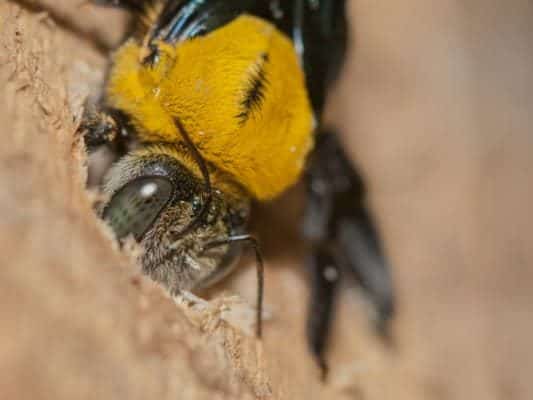
How do carpenter bees drill holes? Carpenters possess mandibles that they use as teeth. They chew the wood to drill perfect holes by moving their mandibles in a circular manner. The process takes them nearly five days to drill a 1-inch deep hole. Once drilling below the surface they turn and follow the grain weakening the timber.
This article will explain in great detail how and why carpenter bees drill holes, whether it is the male or female carpenter bee who cuts the holes, how you can prevent carpenter bee infestations, and a few other related topics.
Why Do Carpenter Bees Drill Holes?
Carpenter bees drill holes to lay eggs and protect the developing larvae.
While the female carpenter bees take care of the eggs and larvae, the males guard the nest. Surprisingly, the male carpenter bees do not possess a stinger and are unable to sting. But humans and other predators are usually intimidated by the size and the violent nature of males. The females can sting but will only do so if seriously threatened.
Although the effect of their sting subsides once you take antihistamines, it can be very painful. Hence, refrain from disturbing them, especially the female carpenter bees.
How Do Carpenter Bees Drill Holes?
Unlike most bees who build beehives to lay eggs, carpenter bees drill holes in wood by moving their mandibles in circular patterns.
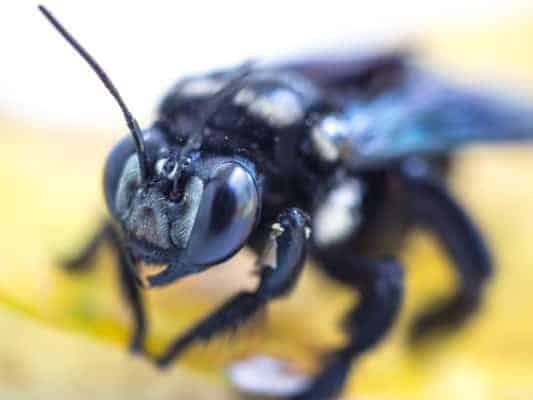
Some of their favorite types of wood include redwood, cedar, pine, and cypress. Carpenter bees are attracted to untreated and natural wood, so they are likely to stay away from painted or varnished wood.
Carpenter bees prefer to drill in wood that is at least 2 inches thick. Here’s why: they use their mandibles to drill holes that are 1 inch deep. After this, they take a right-angled turn and continue drilling. This is to ensure that the holes have enough space to protect all their eggs and larvae.
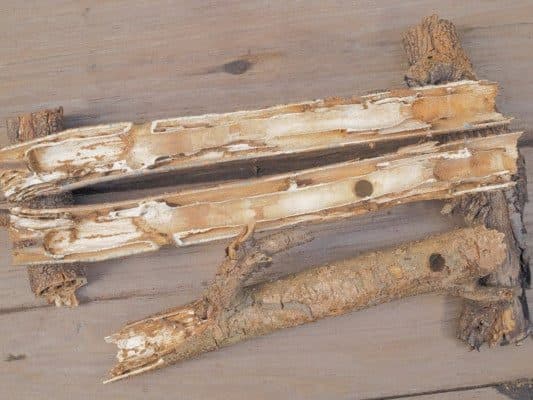
Using their mandibles to drill holes can be tiring for them. The long exhausting process takes 5 to 6 days to make a 1-inch deep hole.
Are The Carpenter Bees Eating The Wood?
Carpenter bees do not eat wood. They only use wood to drill holes to make room for eggs and larvae.
Carpenter bees mainly feed on pollen and nectar and feed their larvae a mixture of pollen and regurgitated nectar, often referred to as bee bread.
The female carpenter bees collect pollen and nectar and stock it in the nests. Once there is enough food for the larvae, she lays eggs on it and seals the cavity.
Is It Males Or Females Drilling/Cutting The Holes?
The female carpenter bees drill the holes while the males guard the nest.
The females collect nectar and pollen, take them back to the nest and leave it in the holes. Once they are ready, the female bee lays eggs and takes care of the developing larvae.
On the other hand, the male protects the female bee and the larvae from predators and humans. When an attacker comes near the nest, the male carpenter bee buzzes loudly and flies at them aggressively. The predator will most likely become scared of the size and the violent nature of the male carpenter bee.
Do Carpenter Bees Damage Homes?
Carpenter bees can cause extensive damage to wooden structures of your house and even wooden furniture you may have outside. The holes these bees drill in wood are approximately 1.5 to 2 inches in length!
Also, the carpenter bees will reuse the same site every season to lay eggs, which will result in longer holes. Over time this network of holes drilled by carpenter bees can compromise the structural integrity of part of your house. This can not only be unsafe causing a real risk to people it can also be expensive to fix or replace.
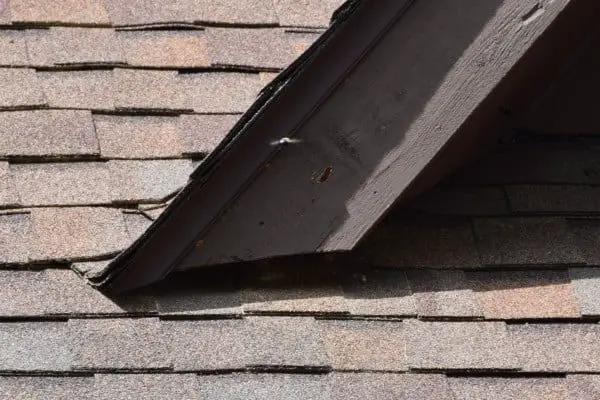
In the case of a carpenter bee infestation, it is important to take the precautionary measures to prevent structural and property damage, and to keep the wooden structures in good shape. Furthermore, their feces can stain wood and change its color to yellow-brown.
Signs Of A Carpenter Bee Infestation
Treating bee infestations as soon as they occur is critical to eradicating the problem effectively. If you have noticed carpenter bees in your home or surroundings, look out for these signs, which indicate that it is time to take proper measures and contact a pest control professional.
1. Holes In Wood
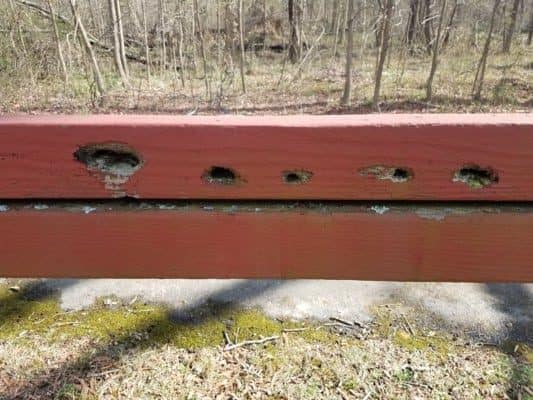
The most common sign of a carpenter bee infestation is the presence of small, round holes in wooden structures. Inspect your wooden furniture and logs lying nearby to determine if there is a bee infestation.
2. Cracks And Crevices
Carpenter bees often enter homes through cracks and crevices. Therefore, seal all such holes using steel wool, putty, or wood glue. If you notice such openings, look out for carpenter bees inside your home.
If you want to know how to seal cracks and crevices in your home extensively, check out Four Steps to Seal Cracks and Crevices..
3. Pollen And Feces
Carpenter bees feed on nectar and collect pollen and nectar to store in their nests. If you notice holes in wooden structures, examine its surroundings to see if there are yellowish dusty specks lying nearby. In addition, search for feces of the carpenter bees that are yellowish brown in color.
4. Sawdust
As the female carpenter bees drill holes, the dust will accumulate on the ground below the wood. Sawdust piles along with round holes in the wood above, is a good indicator that carpenter bees have invaded your home.
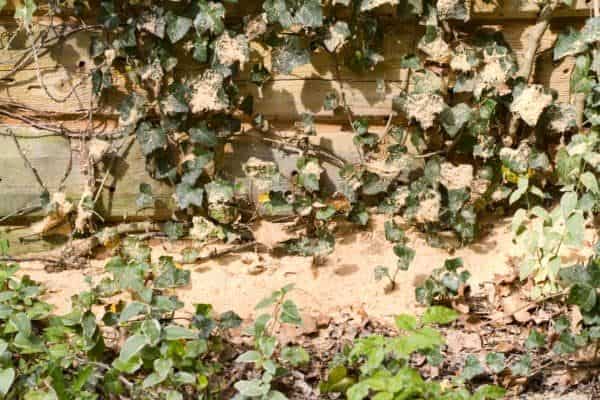
Once you notice any of the above symptoms, carefully evaluate the extent of the damage for some time. If the signs increase, take the measures to get rid of these bees, or contact a pest control specialist.
Read on to know the different ways through which you can stop carpenter bees from drilling and extending their holes.
How Can You Stop Carpenter Bees Drilling Their Holes?
As carpenter bees are important pollinators and help sustain our environment, it is best to prevent carpenter bee infestation rather than killing them.
Here are a few actionable techniques that will keep the carpenter bees away from your home:
1. Paint The Wood
Carpenter bees mostly attack untreated wood and are likely to stay away from painted and varnished wood. Moreover, they find it difficult to stick onto the polished texture of paint and varnish. Apply a fresh coat of paint on wood structures in your home to make it unattractive to these flying insects.
2. Seal All Exterior Openings
Use wood glue or putty to seal all cracks and crevices in your home. Also, remember to shut all the doors, especially during spring seasons, as these bees are most active during this time. If the bees cannot enter your home, they will most likely fly off from the surrounding in search of better places to lay eggs.
3. Seal All Food Containers
Like any other insect, carpenter bees are also attracted by food. If there are crumbs of your favorite snack lying on the floor, the bees will fly indoors to feed on them. Hence, keep the edible items in airtight containers, and seal all the trash cans.
4. Play Loud Music That Sends Off Vibrations
Carpenter bees tend to stay away from loud noises and vibrations, as they are sensitive to these acoustic stimuli. Hence, play loud music near the site of infestation for some time. The bees will most likely leave its nest soon after the music starts playing.
As soon as they fly out of the holes, fill the nests with wood glue, steel wool, or other similar items and seal off the entrance.
5. Chemicals And Non-toxic Liquids
Once you find out the nesting site, spray almond oil, citrus oil, or a chemical on the holes. The scent of these liquids repels carpenter bees. As a result, the bees fly out of their nests. When approaching the infestation site, wear protective gear. If you disturb the nests, the female carpenter bee will sting, and it can be painful.
6. Carpenter Bee Traps
This is a convenient method of getting rid of carpenter bees. Most traps are in the shape of a small wooden box with drilled holes. The idea is to trick the carpenter bee into thinking that it is an excellent site to lay eggs.
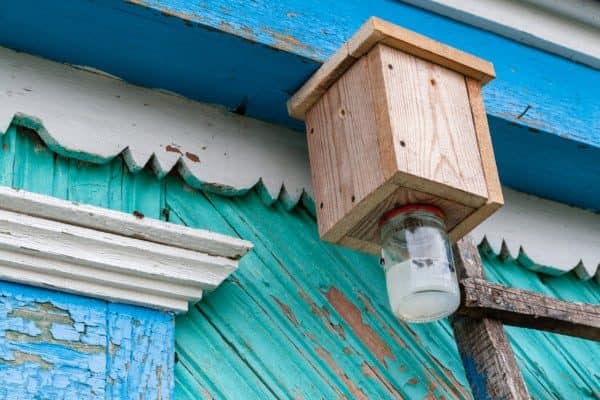
When the carpenter bees enter the box, they fall into a plastic bottle that is attached to the box. The bees will be trapped inside the bottle, unable to escape. Since they cannot access food, they will most probably starve to death within a few hours.
7. Sprays And Pesticides
Several sprays and pesticides are available in the markets that can kill carpenter bees. They come in the form of dust, liquid, or small pellets. While using the insecticidal sprays, always wear protective gear and take proper precautionary measures.
8. Hire A Professional
These tips are pretty simple to administer and will keep the bees away. However, if the infestation is quite extensive, it is always better to contact a certified pest control professional. Also, seek advice from the pest control specialist on preventing such infestations in the future.
The Wrap Up
Carpenter bees do not have teeth, so they use their mandibles to drill holes in wood. Once the hole is 1 inch deep, the bees take a right-angled turn and continue drilling to make enough space for the larvae.
Though these carpenter bees can bring potential damage to timber structures in and around your home, they are good pollinators. So where possible it is good practice to make the timber sturctures around your home less attractive to carpenter bees.
Having said that is you have an infestation of carpenter bees you need to act quickly because that can cause serious and costly damage to your home.
